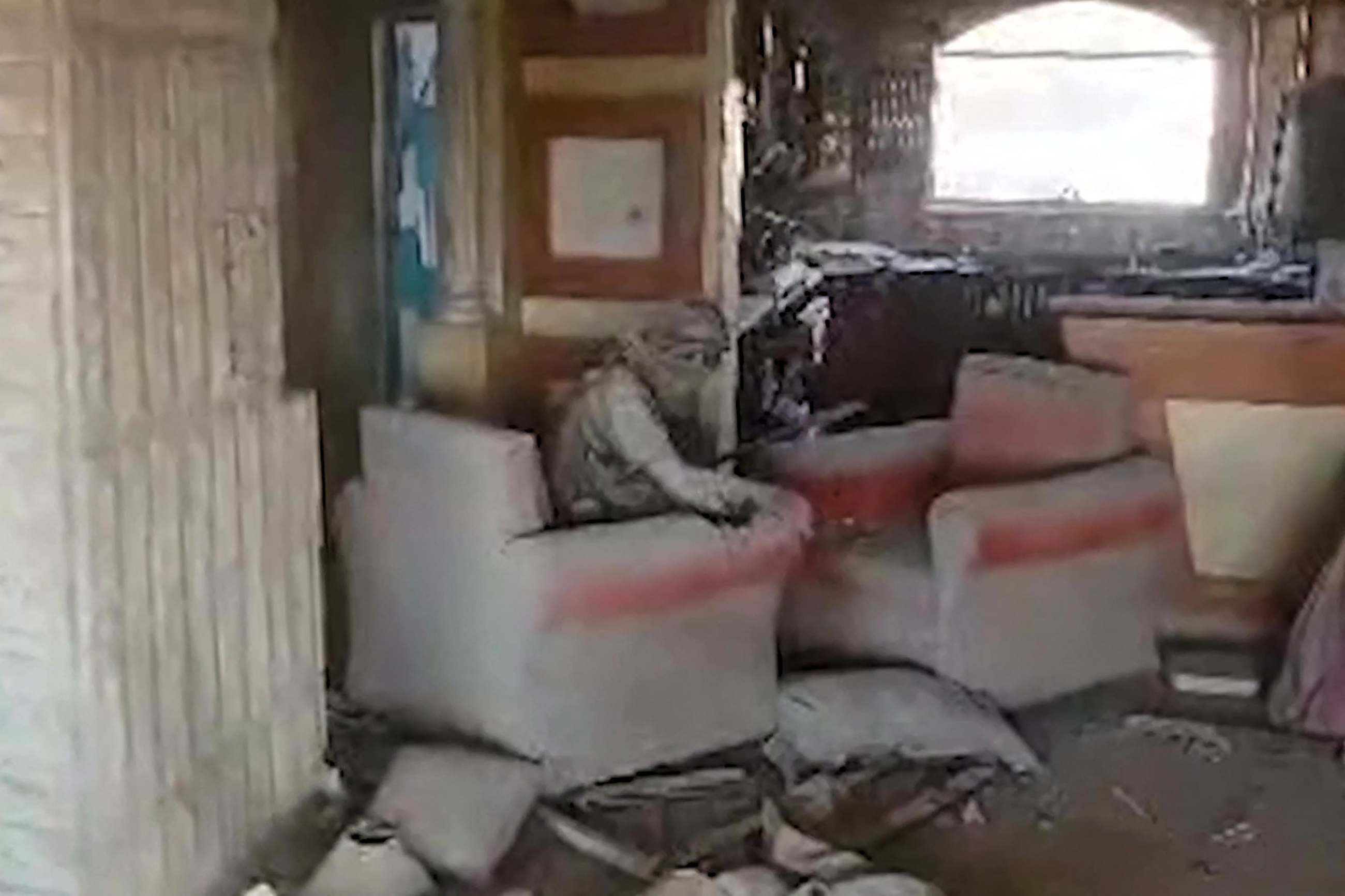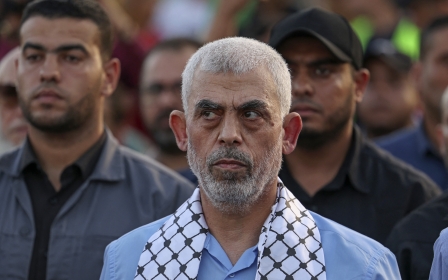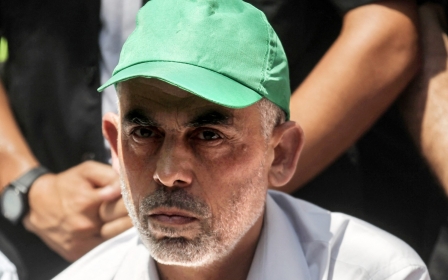Yahya Sinwar’s final moments turned into 'symbols of resistance' by social media users

Images of Yahya Sinwar’s final moments have sparked a wave of art, protest and commentary across the Arab world and beyond.
Sinwar, who was leader of Hamas and one of Israel’s most wanted figures, was killed during an Israeli military operation in Gaza on 16 October, a year into Israel's devastating assault on the Gaza Strip.
Many observers, activists and Palestinians interpreted his last minutes, which were captured on drone and released by the Israeli army, as emblematic of resistance and sacrifice.
The footage, which has circulated widely online, appears to show Sinwar, wounded and with a severed arm, covered in the dust of a partially demolished building. When he sees the drone, he throws a stick towards it in a gesture many online described as a "last act of defiance" and as symbolic of the Palestinian cause.
This image has become a focal point in protests and artistic renditions across the world.
New MEE newsletter: Jerusalem Dispatch
Sign up to get the latest insights and analysis on Israel-Palestine, alongside Turkey Unpacked and other MEE newsletters
Hamas is proscribed as a terrorist organisation in the UK, US and EU. Sinwar is widely thought to be the architect of the 7 October Hamas-led attacks on southern Israel, in which over 1,100 people were killed and around 250 were taken captive.
“Does the world expect us to be well-behaved victims while we are getting killed? For us to be slaughtered without making a noise?”
— Muhammad Jalal (@MJalalAf) October 19, 2024
- Yahya Sinwar. pic.twitter.com/y0136U7Uxe
One of the most prominent depictions following his killing is an image of him wearing a keffiyeh and sitting on a couch among rubble - a rendition inspired by an image taken whilst he was still alive.
Think Yahya Sinwar has immortalised the reclining in a couch pose …
— Maria (@mariaa_awd) October 18, 2024
Surrounded by the ruins of what once was; proud, defiant in both and hauntingly composed in this last image aware that it’s his time . pic.twitter.com/F7qMQcZrYT
This image has become a rallying point for demonstrations, including in Morocco, where over the weekend protestors reenacted his pose while wearing masks of his likeness as well as carrying posters of his face.
✅ الشعب المغربي يخلد مشهد العزة والشموخ والبطولة للقائد السنوا-ر
— hassan bennajeh - حسن بناجح (@h_bennajeh) October 20, 2024
📌من مسيرة الدار البيضاء 20-10-2024 pic.twitter.com/sb9M64EqxT
Some Palestinians have also shared pictures of themselves reenacting the pose.
Meanwhile, photographs of children dressed up as Sinwar, posing with sticks and keffiyehs, or playacting his final moments are also being shared on social media.
Some images have superimposed Sinwar's face onto figures like Che Guevara, a Argentinian-Cuban revolutionary killed in Bolivia in 1967 who became a leftist icon.
Several people also drew parallels between Sinwar’s death and that of Omar al-Mukhtar, a Libyan anti-colonial resistance leader who was executed by the Italians for refusing to submit to colonial forces.
Why would the Z¡onist show Al Sinwar’s last moments fighting till his last breath on the front lines?
— السامرائي🔻Mohamed (@M_Samaraie_) October 18, 2024
Not even Al Sinwar dreamed of a better televised and recorded heroic end to his life & the beginning of his true legacy.
Because colonizers do not understand the concept of… pic.twitter.com/Adm51jHWkW
Many users paired al-Mukhtar's famous quote “We win or die; we don’t surrender,” with photos of Sinwar, and suggested that Sinwar will be remembered in a similar light.
Social media users also shared artwork inspired by Sinwar’s death, including drawings and AI-generated images, with captions quoting his past statements, such as, “Does the world expect us to be well-behaved victims while we are getting killed?”
Some cartoon representations of his final moments depict him with a wounded arm or dressed in combat gear.
'Sinwar's stick'
Meanwhile, "Sinwar's stick" has been shared as a metaphor for resistance.
In one line drawing, Sinwar throws his stick at an Israeli soldier, as well as men dressed in traditional Arab clothing, in apparent reference to Arab leaders who have normalised relations with Israel.
"وَأَوْحَيْنَا إِلَى مُوسَى أَنْ أَلْقِ عَصَاكَ فَإِذَا هِيَ تَلْقَفُ مَا يَأْفِكُونَ فَوَقَعَ الْحَقُّ وَبَطَلَ مَا كَانُوا يَعْمَلُونَ فَغُلِبُوا هُنَالِكَ وَانْقَلَبُوا صَاغِرِينَ وَأُلْقِيَ السَّحَرَةُ سَاجِدِينَ قَالُوا آمَنَّا بِرَبِّ الْعَالَمِينَ رَبِّ مُوسَى… pic.twitter.com/we75rzVvQD
— د. محمد ابوعرف DrMo (@abu_orf) October 19, 2024
One user even suggested that "Sinwar’s Stick" could become a new Arabic proverb, meaning perseverance against overwhelming odds.
Several social media users compared Sinwar's use of a stick in his final moments to the words of Palestinian professor, scholar and poet Refaat Alareer, who, in the weeks before he was killed in an Israeli air strike, said he would throw classroom markers at Israeli soldiers if they ever raided his school, "even if that is the last thing that I would be able to do".
Holding a stick has become a symbol of resistance. Every child will be inspired by Shahid Sinwar. #Yahya_Sinwar pic.twitter.com/7U7SbmNQtf
— Sayyid Muhammad 🔻 🇵🇸 🇾🇪 🇱🇧 🇮🇷 🇮🇶 🇸🇾 (@SayidMuhammad72) October 19, 2024
In contrast, Israeli officials and their supporters have celebrated Sinwar's death and slammed those who shared images of the former Hamas chief in a heroic light.
Avichay Adraee, the Israeli military spokesperson, described Sinwar as "defeated, outcast, and persecuted," a message that has been widely shared in Israeli media outlets.
Israeli media showed soldiers distributing sweets in reaction to the news of his killing, and others celebrating with drums, chants and waving Israeli flags.
Middle East Eye delivers independent and unrivalled coverage and analysis of the Middle East, North Africa and beyond. To learn more about republishing this content and the associated fees, please fill out this form. More about MEE can be found here.




